Book now
So much to see and so little time! Spend the night in Antwerp or take a guided tour.
How and where to park your car in Antwerp.
introduction
Are you planning a trip to Antwerp and wondering how and where to park your car? Finding a parking spot in a city can be a daunting task, but with a little bit of knowledge, it can be a breeze. This guide will discuss the various options for parking in Antwerp, including on-street parking, off-street parking, and special arrangements for specific needs. By the end of this guide, you will have a better understanding of where and how to park your car in Antwerp, making your trip stress-free and enjoyable
In Antwerp, there are several options for parking your car, including on-street parking and off-street parking. On-street parking is regulated and restricted in certain areas and requires payment, usually through a zone system. Off-street parking is available in the form of parking garages and lots, with varying locations and prices. With a little research, finding a parking spot that suits your needs and budget in Antwerp is possible.
Short of time to read the whole article? Go directly to your favorite topic via the table of contents.
Low Emission Zone (LEZ)
The Low Emission Zone (LEZ) in Antwerp is a designated area where certain vehicles with higher emissions are restricted from entering. The goal of the LEZ is to improve air quality and reduce pollution in the city center. From a specified date, vehicles that do not meet certain emission standards, particularly older and more polluting ones, are not allowed to enter the LEZ. Only vehicles that meet the required emission criteria, such as Euro standard norms, are permitted to drive within the zone. To ensure compliance, cameras and automatic license plate recognition systems are used to monitor vehicles entering the area. Non-compliant vehicles may face fines. The LEZ in Antwerp is an important measure taken by the city to create a healthier and more sustainable urban environment.
More info: The Low Emission Zone (LEZ) in Antwerp
On-street parking
Regulations and restrictions:
When it comes to on-street parking in Antwerp, it is important to be aware of the regulations and restrictions that are in place. The city operates a zone system, with different areas designated for different types of parking. Blue zones are for paid parking, while green zones are for free parking, but with time restrictions. Yellow zones are for residents only and require a special permit. It’s important to pay attention to the signs and parking meters in each zone, as they will indicate the specific regulations and restrictions that apply in that area. Additionally, there are certain streets and areas where parking is prohibited altogether, such as in front of schools during school hours and in front of emergency vehicle access. Violating these regulations can result in fines, so it’s important to familiarize yourself with the rules before parking your car. It’s also important to note that parking regulations and restrictions may be different during certain events or holidays.
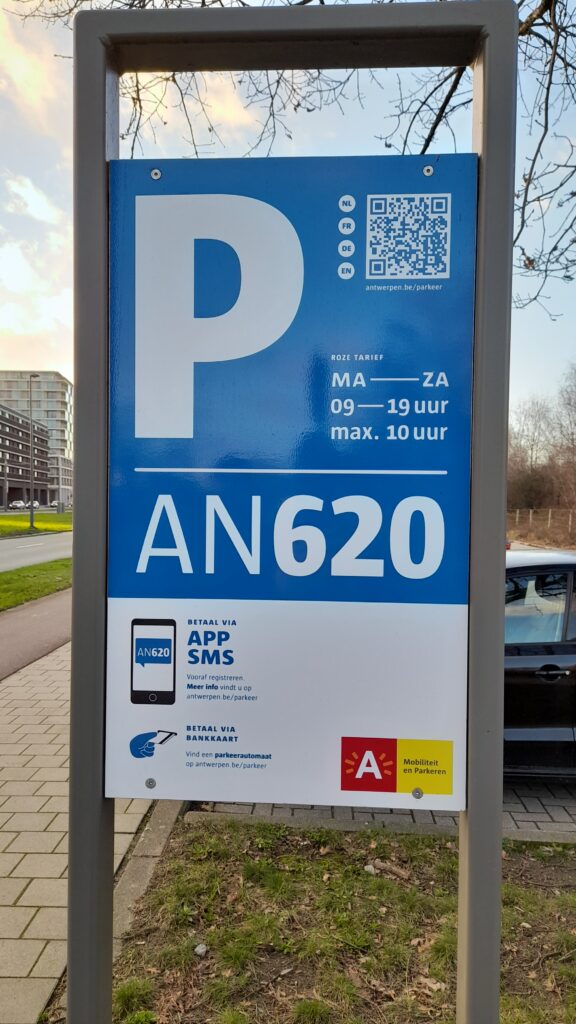
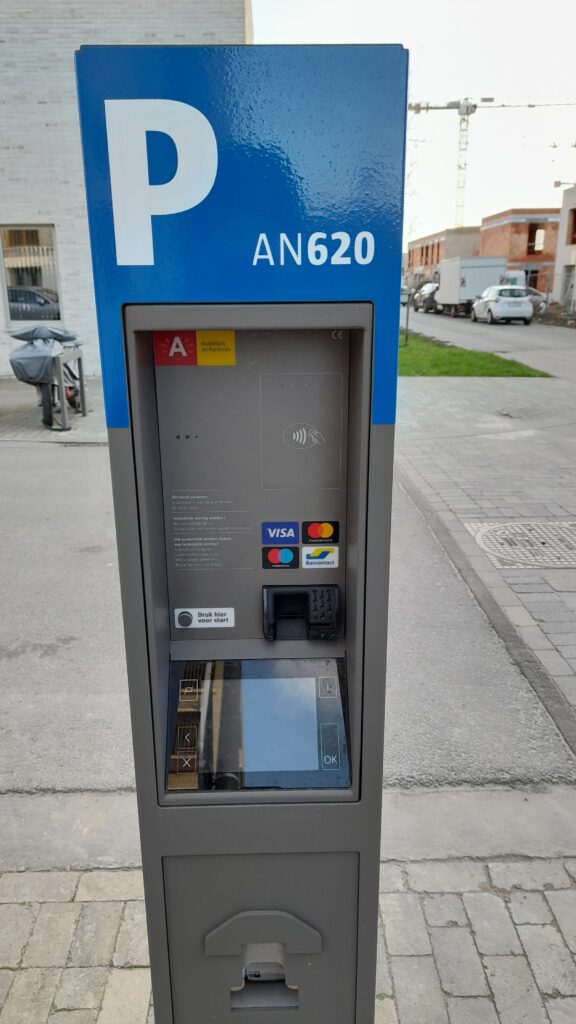

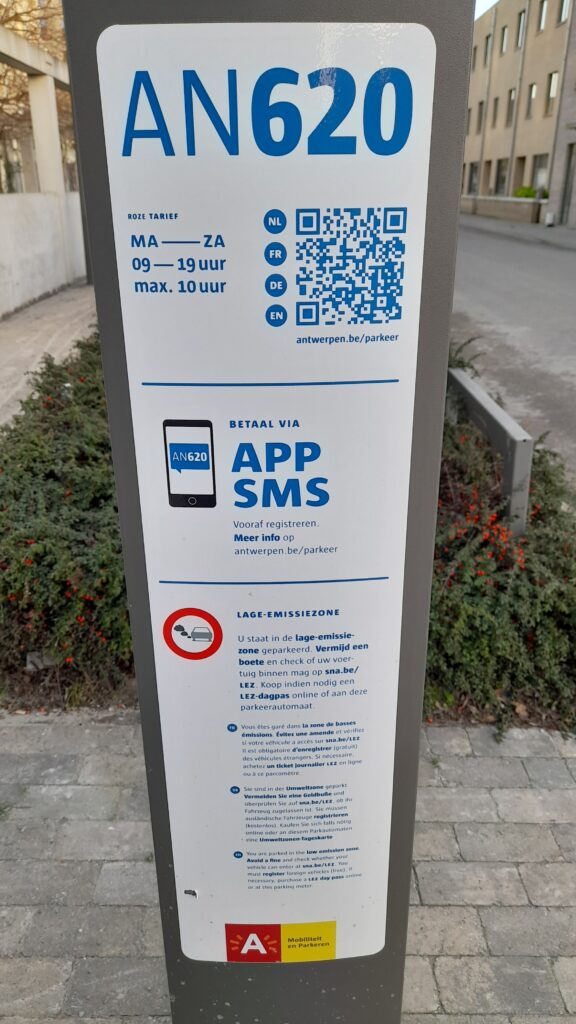

Payment options
When it comes to paying for on-street parking in Antwerp, there are several options available. The most common method is to use the parking meters located on the street, which accept credit/debit cards. These meters typically display the time limit for parking in that particular spot, as well as the cost per hour. Another option for paying for on-street parking is through a mobile app, such as 4411. This allows you to pay for parking and extend your parking time remotely, eliminating the need to return to the meter to add more time. It’s important to check the options available in the specific parking zone you will be parked in. Having multiple payment options can make the parking experience more convenient and stress-free.
Zone system
A part of the historic city center is located in the red parking zone.
Parking tariff zone Red
Schedule: 9-22 hour
Base fee: €2,30
Extra fee: 2nd hour: + € 3,40 / 3rd hour: + € 5,70
Max. duration: 3 Hour(s)
Daypass: Not applicable
Important update from 1 august 2023
Starting from August 1, 2023, Antwerp’s historic center will see the introduction of a new parking zone with specific regulations. Only residents holding parking permits and certain permit holders will be allowed to park on the streets within this zone.
The designated parking area includes streets like Brouwersvliet, Ankerrui, the Leien, Scheldestraat, Kronenburgstraat, Kasteelpleinstraat, and the River Scheldt. Streets on the outskirts, however, will not be part of the new parking zone.
Residents within the zone will still enjoy unrestricted free parking in their residential areas with a valid parking permit. Additionally, their visitors can park on the street for up to 3 hours using a resident pass, which costs €3.80 per hour.
Visitors and tourists without a pass will no longer be permitted to park on the streets within the new “permit holders zone” starting August 1, 2023.
They can however still park their car in any parking garage located in the city center !!
Care providers, including nurses, healthcare professionals, midwives, physiotherapists, and doctors, can purchase a specific parking permit for care providers starting August 1, 2023.
Users of shared vehicles from professional providers like Poppy, Cambio, Green Mobility, or Miles Mobility can park anywhere in the city, including the new parking zone.
In Nationalestraat, parking will be time-limited (max. 30 minutes) during store hours but available to residents and permit holders outside store hours.
Off-street parking
Off-street parking in Antwerp can be found in the form of parking garages and parking lots. These facilities offer a more secure and sheltered option for parking your car, and can often be more convenient than on-street parking. In the historical center of Antwerp, you can park on-street for a maximum time of 3 hours.
One option for off-street parking is parking garages, which are located throughout the city. These garages typically offer hourly and daily rates. Some garages also offer reserved parking spaces, which can be booked in advance. It’s important to note that the prices for parking in a garage can vary depending on the location and the time of day, so it’s a good idea to compare prices and check for discounts or promotions.
Off-street parking can be more expensive than on-street parking but offer more protection and security to your car and can be more convenient. It’s important to check the location and prices of the parking garages and lots, and compare them with the on-street parking options to find the best option for your needs and budget.
All off-street parking garages in Antwerp
Prices
The prices for parking in Antwerp can vary depending on the type of parking, location, and time of day. On-street parking in the red zones typically ranges from €2,30 to €5,70 per hour, depending on the duration of parking. Max duration of parking is 3 hours.
The prices for off-street parking in garages and lots can also vary, with hourly rates typically ranging from €2 to €4, and daily rates ranging from €10 to €25. Monthly and long-term parking rates are also available, which can be more cost-effective for those who plan to park in the city for an extended period.
Some garages and lots offer discounts or promotions, such as early bird or night rates, so it’s worth checking for these options when looking for parking. Keep in mind that it’s always better to pay for parking rather than risk a fine for parking illegally.
Park and rides
One great option for those looking for parking in Antwerp is the “park and ride” system. Park-and-ride facilities are located on the outskirts of the city and provide a convenient and cost-effective option for those who are planning to take public transportation into the city center. The idea behind park and ride is to reduce traffic congestion and air pollution by encouraging the use of public transportation.
The Park and Ride facilities in Antwerp offer secure and affordable parking. Some of the park-and-ride facilities also offer reserved parking spaces, which can be booked in advance. Once parked, you can take a tram, bus, or train to the city center, avoiding the hassle of finding parking in the city center.
The park-and-ride facilities are strategically located near the major highways and major public transportation routes making it easy to access the city center. Some of them also offer EV charging stations. It’s a great option for those who are planning to spend the day in the city and want to avoid the stress and expense of finding parking in the city center.
The park-and-ride system in Antwerp is a great option for those who are planning to take public transportation into the city. It offers secure, affordable, and convenient parking, and is also an environmentally friendly option. It’s important to check the location, availability, and prices of the park and ride facilities in Antwerp before using them.
More info on official website park-and-ride
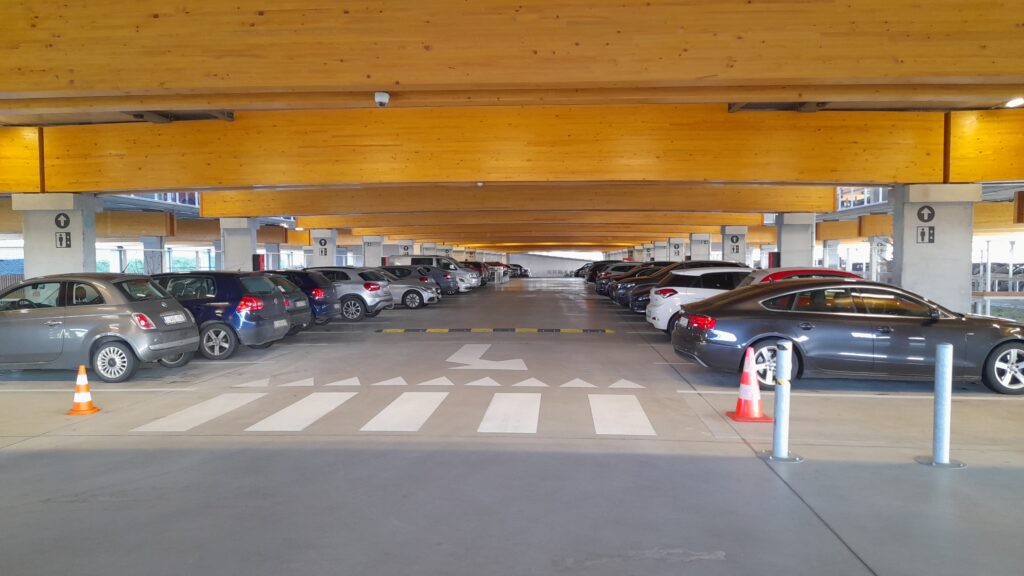

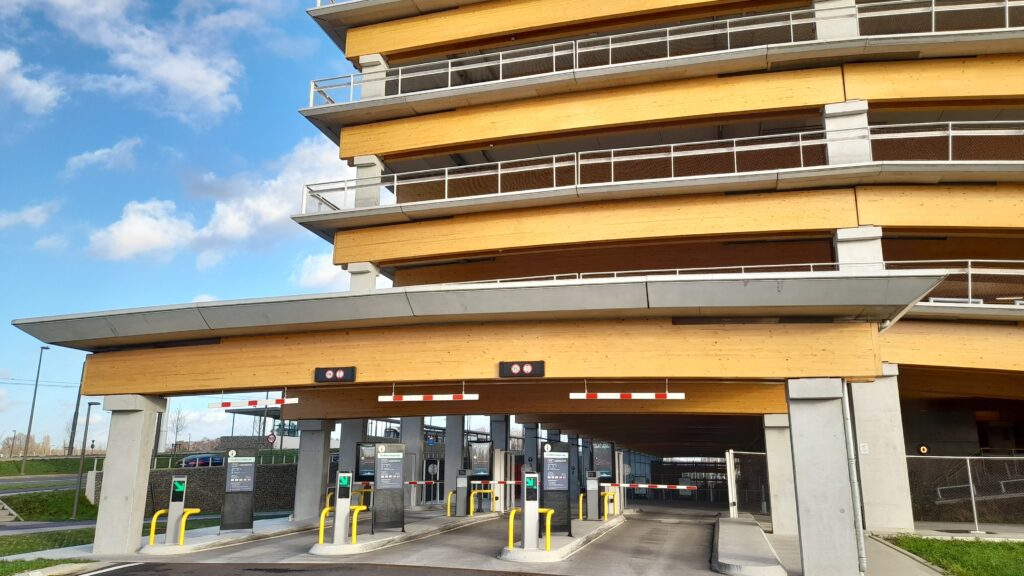

Where can you park for free in Antwerp?
The entire historic city center is in the red parking zone and no longer has a free parking zone. In other parts of Antwerp, there are a few options for free on-street parking, although these options may be limited and have certain restrictions.
How do you pay for parking in Antwerp?
In Antwerp, there are several options for paying for parking, including:
- Parking meters: These are located on the street and accept credit/debit cards. The parking meter will indicate the cost per hour and the time limit for parking in that spot.
- Mobile app: You can pay for parking using a mobile app such as 4411. This allows you to pay for parking and extend your parking time remotely, eliminating the need to return to the meter to add more time.
- paying with sms.
- cash in parking garages.
It’s important to note that different parking zones may have different payment options available, so it’s best to check the signs or contact the local authorities for more information. Additionally, it’s always a good idea to have coins or a credit card on hand as a backup, in case the preferred payment method is not accepted.
Special parking arrangements
Disabled parking
In Antwerp, special arrangements are made for those with disabilities to make parking more accessible. There are designated parking spots for disabled drivers and passengers throughout the city, which are typically located near buildings and other amenities. These spots are marked with the international symbol of accessibility and are usually wider than regular parking spots, making it easier for wheelchair users to get in and out of the car.
To use these spots, drivers must have a valid disabled parking permit, which can be obtained from the local authorities. These permits are usually issued to individuals with a permanent or temporary mobility impairment and allow them to park in designated disabled parking spots in Antwerp and other cities in Belgium.
It’s important to note that parking in a disabled spot without a valid permit is illegal and can result in fines.
disabled parking spots in Antwerp provide a convenient and accessible option for those with mobility impairments, and the city makes an effort to ensure that these spots are well-marked and located in convenient locations.
Electric vehicle charging stations
As the use of electric vehicles (EVs) becomes more popular, finding a charging station in Antwerp has become an important aspect when it comes to parking. The city offers several EV charging stations throughout the city, which can be found in parking garages, public parking lots, and on the street. These charging stations are usually operated by different companies and networks, so it’s important to check the availability and the cost of the charging service before using it.
The city of Antwerp is making an effort to increase the number of EV charging stations to support the growing number of electric vehicles on the road, and it’s an important aspect to consider when it comes to parking in Antwerp.
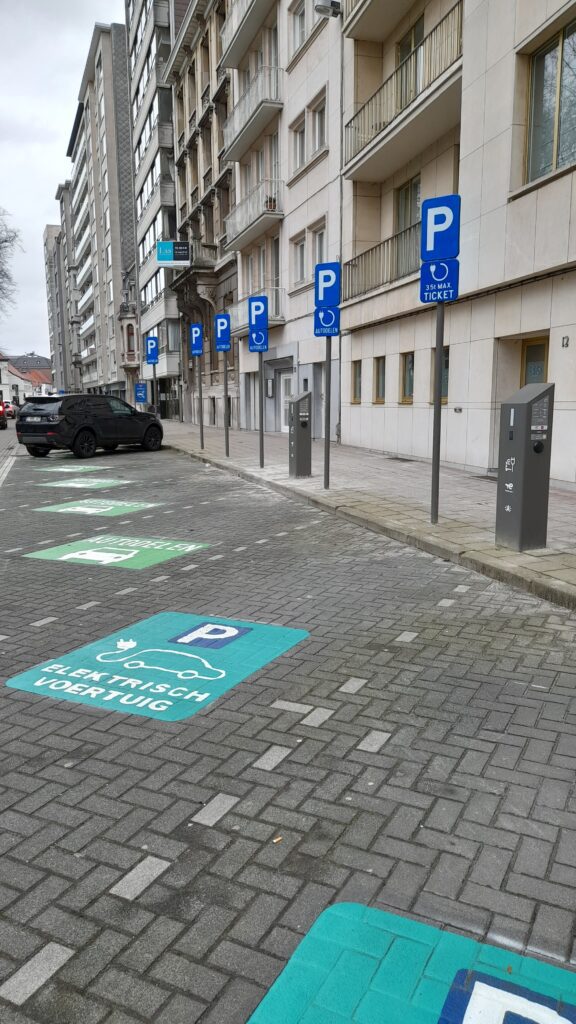

Conclusion
Summary of key points
In conclusion, parking in Antwerp can be a bit challenging, but with a little bit of knowledge, it can be a breeze. The city offers a variety of options for parking, including on-street parking, off-street parking, and special arrangements for specific needs such as disabled parking and electric vehicle charging stations.
On-street parking is regulated and restricted in certain areas and requires payment, usually through a zone system. It’s important to pay attention to the signs and parking meters in each zone and be aware of the regulations and restrictions that apply in that area. Off-street parking is available in the form of parking garages and lots, with varying locations, prices, and reservation options.
Parking prices can vary depending on the type of parking, location, and time of day, so it’s important to check and compare prices before making a decision. Additionally, some garages and lots offer discounts or promotions, such as early bird or night rates.
Special arrangements are made for those with disabilities to make parking more accessible, with designated parking spots for disabled drivers and passengers throughout the city. EV owners should also keep in mind the availability and cost of EV charging stations when parking in Antwerp.
In summary, the key points to consider when parking in Antwerp are: the regulations and restrictions of the parking zone, the payment options, the location and prices of the parking garages and lots, the special arrangements for disabled parking, and the availability and cost of EV charging stations. With this knowledge, you will be able to find the best parking option that suits your needs and budget, making your trip to Antwerp stress-free and enjoyable.
Additional resources for finding parking in Antwerp.
In addition to the information provided in this guide, there are several other resources available for finding parking in Antwerp. One useful resource is the website of the city of Antwerp, which provides up-to-date information on parking regulations, restrictions, and locations of parking garages and lots. The website also provides information on disabled parking, electric vehicle charging stations, and real-time availability of parking spots in certain areas.
Another useful resource is online parking guides such as Google Maps, which provide detailed information on parking options, prices, and real-time availability in various locations throughout the city. These apps can be used to find the nearest parking spot and also to compare prices and check for discounts or promotions.
more detailed info?
Smart ways to Antwerp (slimnaarantwerpen.be)
Is time too short to see everything in Antwerp? book your hotel stay here and discover more about Antwerp.
Booking.comPeople also read:
This article may contain affiliate links. This means that we receive a small commission when you book something via these links. Of course, this does not cost you anything extra. Did our tips help you? We would love it if you book your trip via the links in the article above. Thank you so much.
FAQ
Read more articles on my Antwerp page.